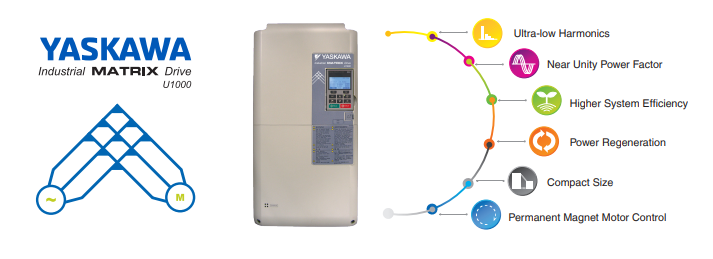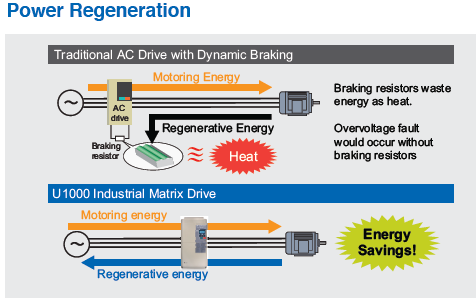Yaskawa Changes the Game with the U1000 Matrix Drive
Matrix Designed VFDs
The Yaskawa U1000 Matrix Drive is a relatively new VFD that was designed as a Clean Power VFD and solution for regenerative power applications. The drive provides low harmonics, with less than 5% iTHD at the input terminals of the VFD and is ideal for a host of industrial applications. The design of the drive obviates the DC bus by using nine bi-directional IGBTs (insulated-gate bipolar transistors) in a matrix arrangement to generate the variable frequency AC output directly from the AC input. With no DC bus to charge, the associated non-linear input current draw can be eliminated.
For drives that use a matrix design like the U1000, any input phase can be connected directly to any output phase at any time. The key to a drive’s matrix operation is its ability to turn the bi-directional switches on and off at the correct times to generate the proper output voltage and frequency required to operate the motor.

Matrix Design and Regenerative Voltage
In addition to the ultra-low harmonics and near-unity power factor, the U1000’s design also provides energy savings through regeneration. When a motor is being driven by a load, as opposed to driving the load, it acts as a generator, sending voltage back to the VFD.
 Examples include applications such as pump jacks, where the load oscillates between motoring and regeneration, and downhill conveyors that are in a continuous regenerative state. Other Regenerative applications include: Solid Bowl Centrifuges, Decanter Centrifuges, Winders, Test Stands, Punch Presses, Escalators and Moving Walkways.
Examples include applications such as pump jacks, where the load oscillates between motoring and regeneration, and downhill conveyors that are in a continuous regenerative state. Other Regenerative applications include: Solid Bowl Centrifuges, Decanter Centrifuges, Winders, Test Stands, Punch Presses, Escalators and Moving Walkways.
In conventional drives, dynamic braking resistors can be used to divert the regenerative energy away from the VFD and prevent a DC bus over-voltage condition. The U1000 design enables the regenerative power to be re-distributed to other loads on the system, which reduces the power required for entire system. This may lead to an overall reduction in the utility bill for the machines in this system.
Matrix Design and EcoMode
The main benefit of VFDs is to enable a fixed-speed motor to operate at variable speeds. However, some applications require full speed for significant periods of time. In these cases, the U1000 can close the appropriate IGBTs to provide a direct connection between input and output to the motor, thus maximizing efficiency without requiring conventional VFDs to use contactors to bypass the drive. This mode also prolongs the life of the VFD by allowing all the IGBTs to “rest” while maintaining at a steady on/off position.
Power Monitoring
In addition to the U1000’s unique matrix design, the VFD can monitor power in several ways to give instant feedback on energy savings. When provided with the dollar amount per kWh billing rate, the display on the VFD can show the following information on request:
- Power output
- Power consumption
- Regenerative power
- Power saved
- Power bill
Comparing VFDs with a Matrix or Conventional Design
There are also other means to mitigate the harmonics of conventional VFDs. These include active front-ends and multi-pulse transformers, which require significant additional components in combination with the VFD, all of which mean added bulk, cost, and wiring connections. The Yaskawa U1000 matrix drive accomplishes low harmonics all within the drive – three wires in, three wires out, making it the fastest and most easy VFD to commission for regenerative and low harmonic applications.
The U1000 is available in a wide range of voltage and horsepower ratings, typically up to 100 HP at 240 V and 800 HP at 480 V. Look for the same Underwriters Laboratories (UL), Canadian Standards Association (CSA), CE, and Restriction of Hazardous Substances Directive (RoHS) certifications and support for induction, surface permanent magnet, and interior permanent magnet motors. With heightened requirements for sustainability and compliance to IEEE 519-2014, matrix VFDs like the Yaskawa U1000, provide a cost-efficient, space-efficient, and energy-efficient means for applications. The Yaskawa U1000 Matrix Drive also won the Control Engineering’s 2016 Engineers’ Choice Award.
Matrix Drive Resources:
Need Application or Programming Assistance?
Lakeland Engineering has carried the Yaskawa line for over a decade. Let an experienced, local account manager assist with programming your application. Call us today at (855) 544-0321 or email sales@lakelandengineering.com.
About VFDs
Variable frequency drives (VFDs) have benefited from many advancements since their introduction in the 1970s. During most of that time, however, the basic design of the drive remained the same, with improvements in performance, size, and cost coming mainly from advances in the drives’ semiconductor components.
From the beginning, VFDs have been used to control the speed of electric motors, which consume approximately 25% of the world’s electrical energy in industrial and commercial applications. By definition, VFDs enable users to operate a motor at any commanded speed, as opposed to running across-the-line at a fixed speed.
In the HVAC Industry, this variable speed control improves energy efficiency and lessens the wear and tear on mechanical couplings, such as gears, belts, and pulleys. In the Industrial Automation Industry, VFDs can be used to control speed and/or torque for more precise process control, increase performance, improve throughput and coordinate steps in a process.
Conventional VFDs
Despite the advantages of energy savings and extended equipment life, VFDs at times also can have an undesired effect on electrical equipment in their proximity. By nature of their conventional design, VFDs are non-linear electrical loads. That means that their input current does not follow the same sinusoidal waveform as the supply voltage because conventional VFDs convert AC voltage to DC voltage.
The problem with converting AC voltage to DC voltage is that current harmonics are often affected. Current harmonics can cause cables to overheat, circuit breakers to trip, and put stress on upstream transformers. Significant current harmonics can have a negative effect on the source’s ability to provide clean power, which in turn can result in voltage distortion, equipment disruption, and power company fines.
Two major industries where harmonics can be an issue are Industrial HVAC and Water and Wastewater Treatment. Facilities in these industries usually have a large number of VFDs which can be very large in horsepower rating. Therefore the VFDs can make up a large percentage of load on the supply transformer, which may lead to the issues mentioned above.